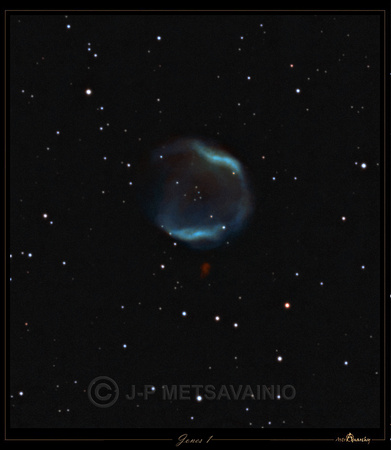Jones1
Natural color composition from the emission of ionized elements, R=80%Hydrogen, G=100%Oxygen and B=85%Oxygen+15%Hydrogen to compensate otherwise missing H-beta emission. This composition is very close to a visual spectrum.
PK 104-29.1, Jones1, a Planetary Nebula in constellation Pegasus.
O-III emission dominates the scene, hence the Bluish color. There is some faint H-alpha emission in a nebula and very dim "blob" of Hydrogen alpha emission just under the nebula. There was no trace of S-II emission.
North is Up and East is Left.
A very hot Central star can be seen as Blue at the center of the Nebula. (Middle one of the Three stars)
I must say, this was the most difficult target ever, due the extremely low surface brightness. I did use my "Tone Mapping" method to dig out all the information. This is one of the dimmest Planetary Nebulae.
There is very few images and information of this nebula around.
Technical details:
Processing work flow:
Image acquisition, MaxiDL v5.07.
Stacked and calibrated in CCDStack.
Levels, curves and color combine in PS CS3.
Telescope, Meade LX200 GPS 12" @ f5
Camera, QHY9 Guiding, SXV-AO @ 3Hz
Image Scale, 0,75 arcseconds/pixel
Exposures
H-alpha 9x1200s, binned 1x1
H-alpha 6x1200s, binned 3x3
O-III 16x1200s, binned 1x1
O-III 6x1200s, binned 3x3


